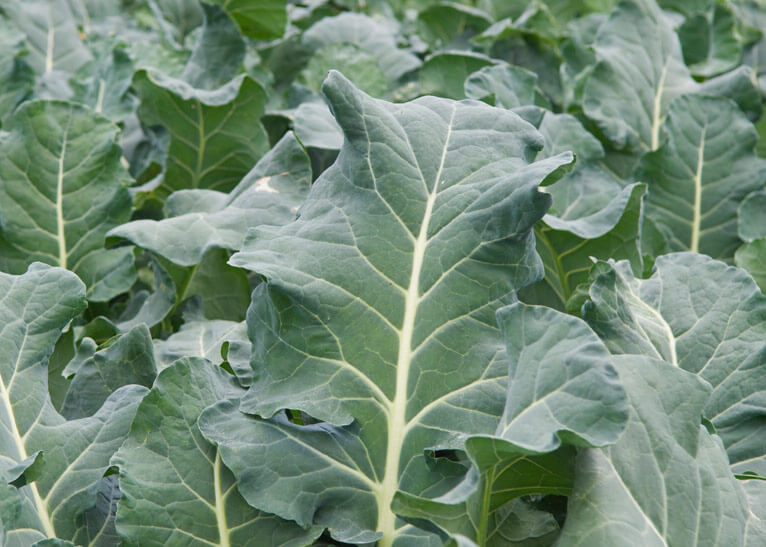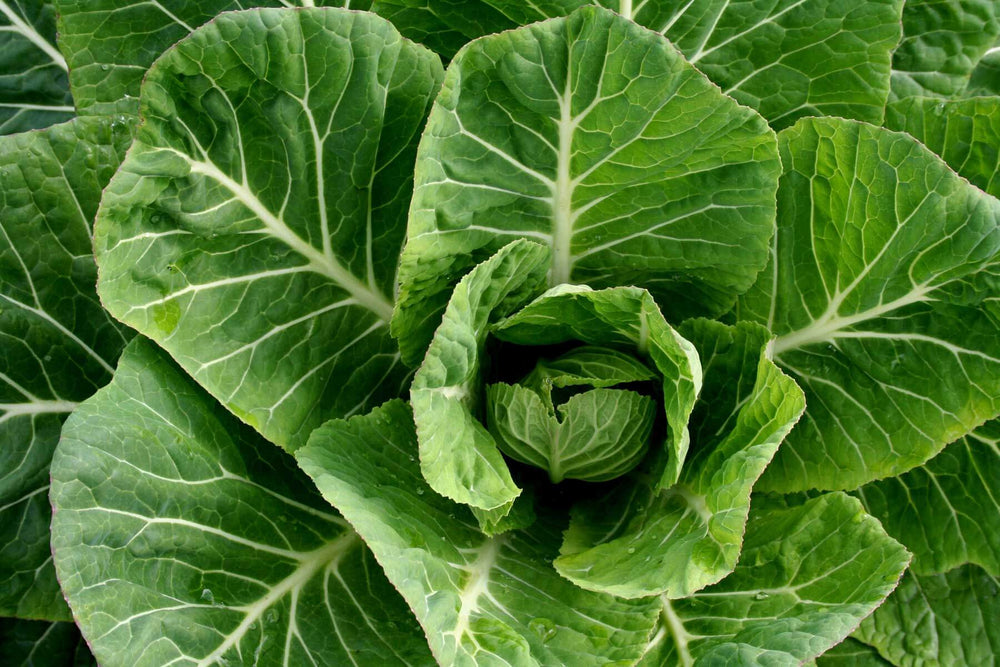If you don't live in the South, you might not see collards very often, though they're gaining popularity in other parts of the country. They are a leafy, cool-weather vegetable very popular for cooked greens. However, growing collards can be done throughout the country. A relative of cabbage, broccoli, Brussels sprouts, kohlrabi, and kale, this upright, dark green, waxy plant is a little like a cabbage that doesn't make a head. It is one of the most cold-hardy of all vegetables, able to withstand temperatures in the upper teens. In zone 8 and southward, collards often provide a harvest through the entire winter. You can plant them in spring and fall, although collards planted in fall gardens are favored because the leaves are sweeter when kissed by frost.
Quick Guide to Growing Collards
- Plant collard greens in spring 3 to 4 weeks before the last frost. These plants will grow well in raised beds, containers, and in-ground gardens.
- Space plants 18 to 24 inches apart in an area with full sun and fertile, well-drained soil with a pH of 6.5 to 6.8.
- Improve your native soil by mixing in several inches of compost or other rich organic matter.
- Collards do best with an even supply of water. Be sure to give them 1 to 1.5 inches of water weekly.
- Collards are fast growers and producers, so it's essential to feed them regularly with a water-soluble plant food.
- Add a 3-inch layer of mulch made from organic material to keep soil moist and prevent weeds.
- Harvest the young leaves of collard greens when they are dark green and 10 inches long.
Soil, Planting, and Care
For faster results and a better chance at success, start with vigorous young Bonnie Plants® collards instead of with seed. Bonnie has been growing plants for home gardeners for over a century, so you know you can rely on us.
Set out spring plants 3 to 4 weeks before the last frost; in late summer, plant 6 to 8 weeks before the first frost for fall and winter harvests. Like all vegetables, collards like full sun, but they will tolerate partial shade as long as they get the equivalent of 4 to 5 hours of sun to bring out their full flavor. Plant in fertile soil because collards should grow fast to produce tender leaves. They need fertile, well-drained soil with a soil pH of 6.5 to 6.8 to discourage clubroot disease. To check your soil pH, test the soil with a do-it-yourself kit or one you can get from your regional Cooperative Extension office. If that's too complicated, forget the testing and simply improve your existing soil with Miracle-Gro® Performance Organics® All Purpose In-Ground Soil, which is enriched with aged compost to create an excellent growing environment for plant roots.
If you plan to grow collards in a raised bed, fill the bed with organic Miracle-Gro® Performance Organics® Raised Bed Mix, a special soil mixture designed to have just the right weight and texture for raised bed growing. For containers, use Miracle-Gro® Performance Organics® All Purpose Container Mix to help collards grow vigorously.
Great soil is only one-half of the equation that equals strong, thriving plants. The other half is premium quality plant food. Feed your plants with Miracle-Gro® Performance Organics® Edibles Plant Nutrition once a week throughout the growing season (follow label directions!) to keep lots of leaves coming on. Since the plants produce so much foliage that gets harvested often, regular feeding goes hand-in-hand with regular harvesting.
Collards are easy to plant. Space them 18 to 24 inches apart. After planting, water and fertilize.
Collards like a nice, even supply of water. Water regularly, applying 1 to 1.5 inches of water per week if it doesn't rain enough to equal that amount. You can measure the amount of water with a rain gauge left in the garden. Apply organic mulch such as compost, finely ground leaves, weed-free hay, or finely ground bark to keep the soil cool and moist and to keep down weeds. Mulching will also help keep the leaves clean.
Troubleshooting
Keep a soil pH of 6.5 to 6.8 to discourage clubroot disease. Although worst on cabbage, Brussels sprouts, and turnips, clubroot affects all members of the cabbage family. The best way to avoid problems is to
Harvest and Storage
Harvest leaves when they are up to 10 inches long, dark green, and still young. Old leaves may be tough or stringy. Pick the lower leaves first, working your way up the plant. You can even harvest leaves when frozen in the garden, but be careful because the frozen plant is brittle. Of course, wash the leaves thoroughly before using them in collard greens recipes, because soil often clings to the undersides. Collard leaves will keep for several days in the refrigerator.




FAQs
When do collards taste the best?
Collards taste sweetest when they grow in cool weather, especially in the fall after the leaves have been touched by frost. Spring-planted collards will grow through summer but they taste stronger when they mature in the heat.
What is the best way to wash collards?
Fill the kitchen sink or a large bucket with cold water. Place collards in a large colander and dunk them several times. Gently shake the greens to remove excess water and blot them dry with a clean towel.
How and where do I store collards?
After collards have been rinsed and thoroughly dried, wrap them in paper towels and seal them in a plastic bag. Keep them in the refrigerator until needed. NOTE: Even slightly moist collards will rot quickly.




 Herbs
Herbs
 Vegetables
Vegetables
 Fruit
Fruit
 Flowers
Flowers
 Succulents
Succulents


